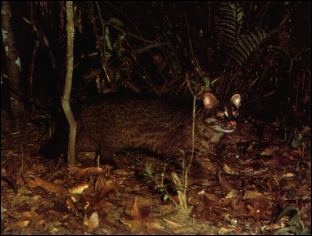|
|
|
|
 |
|
|
The Iriomate Cat (Felis bengalensis iriomotensis) also known to the local people as the Pingimaya. When first discovered on the small island of Iriomote near Taiwan, this small, spotted cat was thought to represent an entirely new species, but is now generally considered to be merely a local race of the Leopard Cat. When it was first encountered, as recently as 1967, by the Japanese zoologist Yoshinori Imaizumi, it caused great excitement. The idea that a new species of feline could be discovered in the second half of the 20th century seemed amazing. |

|
This over-enthusiastic reaction to its discovery has not been sustained, but it is certainly a most interesting sub-species of Leopard Cat and one that deserves protection for further study. Unfortunately, it is a popular food item among the local people, and agricultural development is also robbing it of its sub-tropical rain-forest strongholds. It is now estimated that there are only between 40 and 80 individuals left. These dramatically low numbers must make it one of the rarest forms of wild feline in existence. |
|
|
 |
|
![]()